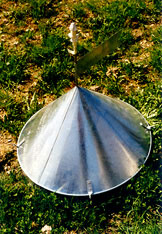 |
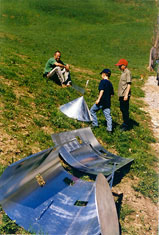 |
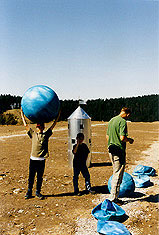 |
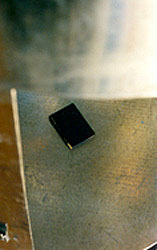 |
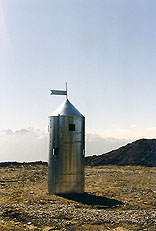 |
In the past the German as well as the Austrian Alpine Association (section
Krain), have had complete authority over the mountain cottages in the
Slovenian hills and mountains. There was no place for Slovenian climbers
and sometimes they had no place to rest. For that reason the priest Jakob
Aljaz bought the land on the top of Triglav mountain in 1895. He bought
the whole peak for only 1 florin. Triglav is the highest and most "sacred"
mountain in Slovenia. Aljaz became a "troublemaker" and provocateur for
German and Austrian authorities. With the help of some friends and on
his own costs he designed and built a simple tower from metal sheets on
Triglav's very top on August 7th 1895. All the metal parts, each of them
weighed between 20-50 kilos, were brought up the mountain by individuals
within two weeks. The tower was put together in five hours. It was a simple
shelter against the bad weather for about four people. This tower was
soon recognized as "ALJAZ TOWER" and became a popular synonym for Triglav
mountain itself. Because of the stubbornness of Aljaz it soon became a
symbol for Slovenian independancy.
Some technical information: The tower is 1.90 m high, roundly shaped with
a cone-cap, anchored to the rocks with three steel wires and a lightning-rod.
On the top, there used to b a small metal flag, which was replaced by
a fiveangular star during World War II. On the outside wall one finds
an inscription in Slovenian "Aljaz Tower/Aljazev stolp". Inside the tower
there are inscriptions in German, French and Russian. The inside walls
are painted with a panoramic view. The tower has also eight small windows
in two lines, with movable glass protectors. Inventary: two gas cookers,
three small round chairs, six metal glasses, two woolen blankets, a registration
book, one barometer and a thermometer - (outside the tower). The tower
was originally protected with a 1 m high stone wall.
One would expect a priest to errect a cross on the top of a mountain.
It was not by coincidence that Jakob Aljaz preferred a tower to a cross.
The tower is a uterine construction, a male phantasy which has turned
into an object.The building can host 4 men; looking for security, they
move close together. And just as the mother's ventral protects one of
tremor and disruption, the metal cover of the tower defends the men against
the biting wind. In this very tower, the phantasm goes, a nation will
be hatched up and born. The mountain as a natural construction of stones
blends with ideological stackings. But this gesture needs the mountain
as well as the futile stones. It is a lonely birth. The men descend from
the mountain and herald a new age. The mountain and blood-soaked river
are holy national myths and in this sense the tower is a sacral production.
LANDschaft und LEIDENschaft (landscape and passion). Jakob Aljaz was a
passionate climber and mountaineer. Thousands of Slovenian men, fighting
under the Habsburg monarchy at the "Soca Front" died there and those battles
still echo in the memory of the people living in this area. This area
is full of historical memory a fact which is significant for the whole
Slovenian nation. In Slovenia's national historiography one thing becomes
blurred with the other, sports and enthusiasm for the landscape, LEIDEN
(suffering) melts with LEIDENschaft (passion). The landscape creates a
topography of the nation. It confronts the dynamics of cultural processes
with eternity and pureness. In Slovenian myths, the water of the river
is red of blood, now it is turquoise (in fact it is emerald green) - i.e.
pure and precious.
Jakob Aljaz sang about the untouched and intact nature on Triglav mountain:
Oj Triglav, moj dom, kako si krasan! O, Triglav my home, how wonderful
you are luring me in summer heate from low hights, to steep peak
to rest my heart in lonliness. Where the cool brook springs from the rock;
O, Triglav, my home, how wonderful you are." It is not by accident
that untouched nature needs technical interference. "ALJAZ TOWER" reminds
one of a rocket in a novel by Jules Vernes, it is a symbol for the governing
of nature through men. Yet Triglav mountain with its changing symbolism
(in its 100 years of existence, the tower has had a lot of different colors)
is exchangeable. The "Monte Piano" and the "Drei Zinnen" have a similar
history. It is therefore fascinating to show Saba Skabernes "ALJAZ TOWER"
at the HIDDEN MUSEUM. The emerald water of the river Soca used to be red
from blood, now it adds turquoise globes. No matter to what extent mountains
and rivers might be used as national symbols, in the end we know all of
them through endless repetition. And however serious conflicts between
nations may be, in the end the constructions and ideas of their national
identities are amazingly similar. Who knows, if things continue like this
"ALJAZ TOWER" might soon be a model for a house bar; a serial production
for living rooms in Slovenia, Germany or Papua Neuguinea.





